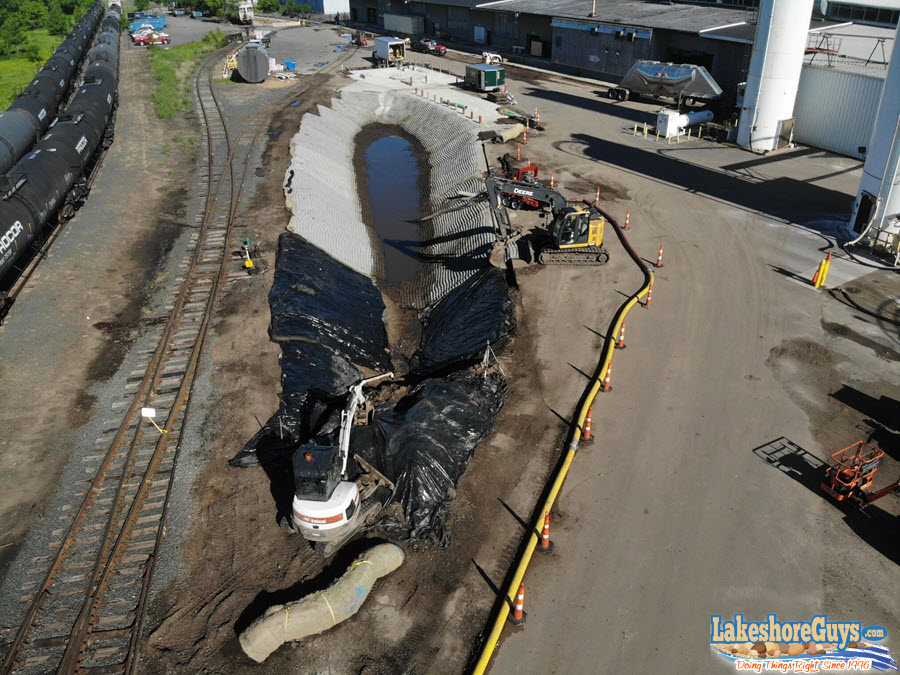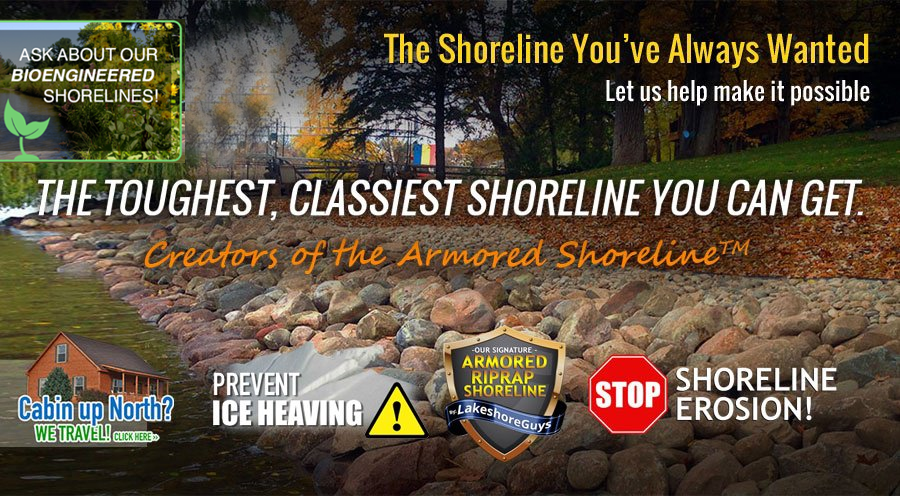Stormwater Basin Erosion Control for Retention Ponds & Detention Ponds on Industrial and Commercial Property in Minnesota & Wisconsin
Our Flexamat or riprap can save your stormwater basin.
You probably aren’t too attached to the stormwater pond. It’s manmade, it doesn’t have a name, and there’s nothing to do there. It exists purely for functional reasons, according to an engineer somewhere, and it seems to capture and hold water well enough. One time you saw a turtle there, and another time you saw a mysterious pair of sneakers. But not much else happens at the pond, so it fades into the background.
That may change soon enough, because the stormwater basin is eroding. As someone who’s responsible for a large piece of commercial real estate, all of a sudden you care a great deal about the pond, or at least how well it can function in its current state.
A stormwater basin is mandatory on many commercial properties. It’s mandatory if you’re near train tracks. It’s mandatory if you manage factory property. (By the way, if you’re a plant manager you probably know that your basin needs to maintain an extra-high capacity at all times: enough not only for flooding, but also to hold any hazmat stored nearby.)
Erosion today may mean overflow and flooding tomorrow, damages after that, and lawsuits after that. The sooner you stop the erosion, the less liability you’ll face, and the sooner you can get back to other problems that need your attention, and get back to your higher calling.
Lakeshore Guys® can help end the erosion of your stormwater basin in Minnesota or Wisconsin. Our stormwater basin remediation process can involve installing concrete erosion-control mattresses, like Flexamat, best-in-the-business riprap installation, regrading of land, possibly other drainage solutions (e.g. native plantings, coir logs, etc.), or some combination of the above.
Our shorelines are built to DNR specifications, and we’re registered Federal Contractors.
We can help you whether you’re here in the Twin Cities, in heavy-industry Duluth, in Wisconsin, or anywhere else in the Midwest.
You may have seen our video of this project (at the top of the page), but here are some before-and-after photos of a big stormwater basin we restored recently:

BEFORE: eroding, undersized, dangerous stormwater basin at factory in Minneapolis.

DURING: in-progress restoration of stormwater basin. Flexamat partially installed.

AFTER: restored stormwater basin with Flexamat at factory in Minneapolis – completed by Lakeshore Guys.
Contact Lakeshore Guys® today to restore your stormwater basin or read on to find out more.
What’s a stormwater pond called, anyway?
We tend to call a stormwater pond a stormwater pond or stormwater basin (the preferred jargon), because both of those terms are clear and self-explanatory, but that sort of body of water goes by other names, too. You may also know it as a:
- Retention pond
- Retention basin
- Detention pond
- Detention basin
- Catchment pond
- Catchment basin
Or something similar. By the way, there is a difference between a retention pond and a detention pond, as you may know: a retention pond is supposed to contain water at all times, whereas a detention pond is supposed to discharge the water somewhere else during a storm and remain dry the rest of the time. Whatever yours is, its purpose is to keep your property (and neighbors’ property) from flooding, and the problem is it’s eroding now.
What kind of properties have stormwater basins?
At least in this lake-heavy part of the country, most commercial and some residential properties of a certain size have a stormwater basin, or at least need one. These may include:
- Industrial property: factories and similar manufacturing facilities. This is the most common, most classic use case by far. We have all kinds of heavy industry here in the Twin Cities, in Duluth, and in Wisconsin. If you’re a plant manager, we can work with you.
- Most commercial properties with train tracks on or abutting the property.
- Shopping centers
- Industrial parks
- Healthcare complexes
- Golf courses
- Universities
- Camps
- Farms & ranches
- Parks
- Housing developments
- Undeveloped land
Most people don’t notice or think much about stormwater basins. But once you start looking around, you will notice they are just about everywhere. Many of them run into problems, sooner or later.
Why do stormwater basins erode?
On most commercial properties, a typical stormwater basin starts eroding for any of a few reasons:
1. Unusually heavy rainfall, over a period of years, months, or even days.
2. Poor drainage on the rest of the land, which can result in excess water filling up the stormwater basin.
3. Other, neighboring stormwater basins that fail and overflow.
4. Time. Over the years, sediment or silt build-up can fill up the pond, reducing the amount of water it can hold before it overflows. Also, most bodies of water change shape over time. That’s how rivers meander, islands are formed, peninsulas are shaped, and so on.
Why is stormwater basin erosion a problem, and why might you need stormwater basin remediation?
A little bit of erosion is inevitable, and is probably a non-issue. But if it’s happened quickly enough that you’re reading this, it’s probably a problem now or will become a problem soon, for any of the following reasons:
1. An eroding stormwater basin can overflow and spread out, causing more land to erode.
2. The erosion and overflow can ruin the drainage on the rest of your land.
3. Flooding or overflow can damage buildings, parking lots, and other infrastructure. (Heavy flooding is a common cause of electrical fires in buildings.)
4. Flooding can damage or pollute abutting land or downhill or downstream bodies of water, opening you up to legal liability.
How do you prevent or stop erosion on a stormwater basin?
One way to restore an eroding stormwater basin is with concrete mattresses, like Flexamat. These are giant rolls of small concrete blocks, connected with a geotextile. The geotextile is loosely woven enough that grass can grow between the blocks. The grass not only helps reduce erosion by itself, but also helps to hold the concrete blocks in place permanently. Here’s a nice short video that explains the general process. The lower, more-submerged parts of the basin we protect with our special custom-made filter fabric, and the upper, drier, landward parts of the basin we may cover with Flexamat or a similar concrete-and-geotextile solution.

Concrete mattress installation – close-up view
Another way to stop stormwater basin erosion is to install riprap – properly. Most landscapers and even some self-styled shoreline specialists don’t install riprap in a way that halts erosion, or what they install crumbles after a couple of years.
In a stormwater basin the fabric (underneath the riprap stones) is even more important than usual. Because wave action is minimal and ice damage is less likely to be a major problem on a small pond, the riprap stones don’t need to provide the same degree of shock-absorption that they do on other, larger, choppier bodies of water. Rather, they serve mostly to protect and to hold in place the fabric, which is what really stops the erosion of a stormwater basin. The fabric holds the land in and keeps it from washing away.

Beyond concrete and geotextile or riprap and fabric, the immediate area of the pond may also benefit from hydroseeding (if there’s more bare dirt than grass). Also, some areas of the property may need to be regraded, like if they discharge water unnecessarily into the storm pond.
Contact Lakeshore Guys® for the best-engineered, best-executed stormwater basin restoration
Lakeshore Guys® can stop the erosion. We use the finest products, we establish and follow industry-leading processes, and we’re used to completing big jobs on-time. We’ve worked on small, tucked-away properties and on factories owned by Fortune 500 companies.
Though we work mainly in Minnesota and Wisconsin, we can travel throughout the Midwest. Contact us today to schedule an on-site consult, stop the erosion, and get back to forgetting about that pond.




